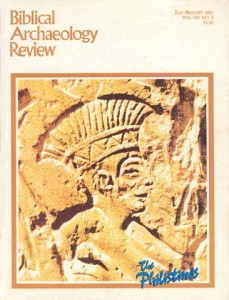Philistines After David
Sidebar to: What We Know About the Philistines
What happened to the Philistines after David? Although their military superiority was shattered, and their distinctive material culture disappeared from the archaeological record soon afterwards, the Philistine people and culture did not vanish. They are referred to in the Assyrian Annals and the Books of Kings and Chronicles as well as by the later Biblical prophets. There is also literary and numismatic evidence that their descendants continued to perpetuate some native Philistine traditions right into the Roman and Byzantine periods.
The Assyrian Annals are the official historical records of the Assyrian kings written in cuneiform script on clay and stone. They date from c. 900–600 B.C. Mentioned in the Annals are several major Philistine cities. The Annals also refer to payments made by Philistine cities to the Assyrian kings.
In the Biblical sources we read of continued tension between the Philistines and Israel and Judah.
“Some of the Philistines brought Jehoshaphat [King of Judah, 871–849 B.C.] presents and silver for tribute.”
(2 Chronicles 17:11)
“And the Lord stirred up against Jehoram [King of Judah, 849–841 B.C.] the anger of the Philistines … and they came up against Judah and invaded it.”
(2 Chronicles 21:16, 17)
“He [Hezekiah, King of Judah, 715–687 B.C.] smote the Philistines as far as Gaza and its territory, from watchtower to fortified city.”
Already a library member? Log in here.
Institution user? Log in with your IP address.

